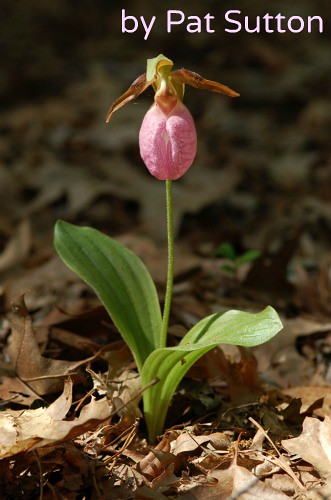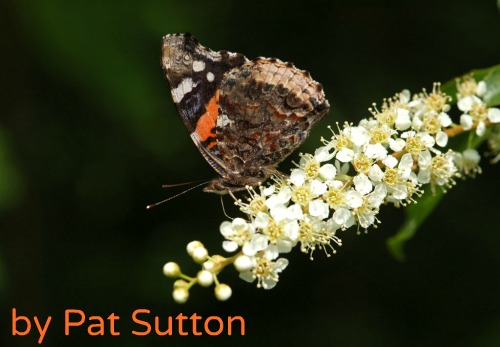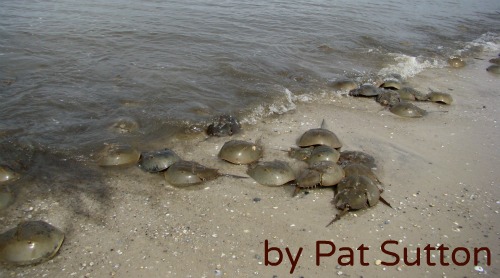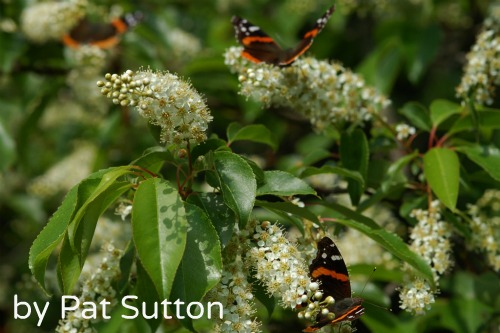
Hi Gang,
I’ve had lots and lots of wildlife gardeners all over New Jersey and the Northeast share their Red Admiral sightings with me. Hopefully you saw some of this mega flight yourself, involving many millions of Red Admirals, so many that cars everywhere couldn’t help but hit hundreds (or probably thousands) of them some days.

My fist awareness of the MEGA Red Admiral movement was on May 1st, the day we returned from presenting a program to Chesapeake Audubon Society in Maryland. Our lilacs were covered with them. We’d just learned that Pink Lady-Slippers were blooming, so visited a woods along Kimbles Beach Road in the Cape May NWR to see them and were astounded by the 100s of Red Admirals (and lesser numbers of American Ladies, Question Marks, and Painted Ladies) pouring out of the woods, all dashing north. That evening I drove to Wildwood on an errand and the flight continued the entire length of my drive . . . I saw 100s of Red Admiral pouring north everywhere along the way, so many that I couldn’t help but hit my fair share of them.


May 3rd I stopped what I was doing (preparing for a “Backyard Habitat for Birds, Butterflies, Dragonflies, and More!” workshop) to drink in the explosion of Red Admirals nectaring on Black Cherry trees. I’d never seen anything like it and could only compare what I was seeing to a butterfly house (where 100s or 1000s of butterflies are raised and released every day into an enclosed butterfly house to entertain visitors). The numbers on each blooming Black Cherry tree were off-the-charts. Every few seconds 100s exploded out of the tree, to land again and continue nectaring. The tree seemed alive with Red Admirals. It was hard to capture on film, so I focused on some portraits of nectaring Red Admirals and Question Marks and American Ladies. I had to pull myself away to get back to work.
May 6th I visited Cape May NWR woodlands on Kimbles Beach Road to show a friend an enormous Red Cedar I’d found (8′ 7″ around at chest height), a real big’n. It was about 10:00 a.m. and we saw a few Red Admirals flitting about. But when we entered the woods it was like entering a magic woodland, in that every sunlit patch of the forest floor was covered with 20-40 Red Admirals (and lesser numbers of Question Marks and American Ladies) that lifted off the forest floor, sailed around, then settled back down onto the forest floor to warm up for the day. We ended this visit by driving the road out to the Delaware Bay shoreline and were dazzled by another natural history show unfolding, 100s of Horseshoe Crabs tumbling in the tideline, mating.

May 8th I was interviewed by Phaedra Laird of NBC 40 WMGM-TV and her cameraman, wanting to learn of the Red Admiral migration. Numbers had dropped off. The Black Cherry trees were still in full flower, but Red Admirals were not in attendance. But our Stinging Nettle patch was another story. I’d dared to plant it in our wildlife garden, just for Red Admirals. I was able to point out Red Admiral eggs on the leaves of my Stinging Nettle. The more I looked, the more I found, until I realized that the patch supported 100s and 100s of eggs. Several female Red Admirals were in attendance, laying more, one after the next. We peeked inside a curled-shut leaf and found a teeny-tiny Red Admiral caterpillar.
Rick Cech and Guy Tudor’s great book, Butterflies of the East Coast, An Observer’s Guide, shares the following really cool natural history information. Red Admirals withdraw from the North each fall and maintain thin, permanent resident populations from the Carolinas south. They steadily repopulate the north every spring, but this movement north usually goes unnoticed. Though about once every 10 years, massive spring flights on the East Coast have been documented: 1981, 1990, 2001, and now 2012. This year’s MEGA flight could be due to the mild winter where many more Red Admirals survived the winter to mate and lay eggs and grow in number until this explosion north.

Looking back at my notes from the May 5-8, 1990 flight Clay reminded me that we’d found 100s washed ashore along the ocean front, individuals that had been blown offshore and never made it back to land. Let’s hope that this flight has not triggered something similar.
Jack Connor has compiled many observations and counts tallied by naturalists all over South Jersey of this MEGA May 2012 Red Admiral spring migration. Go to his South Jersey Butterfly Blog to read these fun accounts: as of May 7 and as of May 5.

Hi Pat,
Thanks for your account, I was able to see these flights a few times in the last week and it was amazing!
Thanks for the back story!
I’ll be watching for your story this afternoon
Hi Lisa, we sure live in a most amazing place, don’t we! Keep enjoying the natural world.
I live in mullica hill and they have been landing on me much to my pleasure!
Hi Susan, me too! What an amazing number we’re seeing. Enjoy them.
Cumberland was inundated on Sunday. While birding in Bevan, they were coming in the car. Also joining them were hordes of angle wings and hair streaks. It was crazy and phenomenal!
Hi Tony, Super cool! Yes, had bunches of Question Marks and American Ladies too, though the Red Admirals stole the show. Wonder what the Hairstreaks were? Red-banded Hairstreaks maybe?
Hi Pat,
I wondered what was going on. Never saw so many, but so wonderful to see them all. I live in Northfield and they arrived late last week, and they are still in my garden. Not as many, but more than normal. Lots of mating going on. I have lilacs that have just come into bloom, a French, dwarf lilac and they are loving that. Lots of other blooming shrubs. Saw you on the TV tonight. And as you commented we live in such a great area to see this amazing influx of butterflies. Love it.
Grace
Hi Grace, my Lilacs are done, kaput! Neat that yours are still enticing Red Admirals. Thank goodness for the Black Cherry trees blooming and all their nectar in our yard. Keep having fun with the natural world.
Sad to say, but I can report that there was a massive die-off of these wonderful migrants along the coast. A co-worker approached me yesterday to ask me about it, because she had been running along the beach in Brigantine and saw hundreds upon hundreds being washed in by the waves.
Hi Angi, so sad but not surprising with so many pouring through and the windy days that blew many offshore. Thanks for sharing. Helps expand on the big picture of their migration north.
This is not just happening along the coast. Here in central Pennsylvania we’ve been noticing more red admirals than usual and on the PA bird listserv, Joe Beatrice mentioned seeing and counting thousands during a trip in upstate NY from Oswego to Watertown to Potsdam.
Hi Marcia, Yes this Red Admiral movement is indeed widespread; many observations are coming in from points north of us here in South Jersey as they keep moving north in mass.
I found your article by searching Google for Red Admiral migration in response to the dozens of questions people have been asking me about them here in Central NJ. It is definitely a butterfly event to take notice of!
Hi Michael, it was astounding wasn’t it. Now major numbers are being seen in NY state. Can’t wait till the 100s of Red Admiral eggs (laid by all those migrants) mature into the next wave of Red Admirals.
I’m not seeing 100s of massed Red Admirals in Morris County, but I’m seeing enough to notice that it’s an increase from recent years. Do individual butterflies actually migrate 100s of miles north in one flight, or are they spreading north from one generation to another in short-distance waves?
I was finding eggs and some catepillars the last couple of weeks, but few Red Admirals anymore. I was reading in Butterflies of New Jersey by Gochfeld and Burger that new broods should be starting to appear by mid June. I look forward to seeing more adult butterfly Red Admirals soon! I wonder hwat their numbers will be?
Hi Sandra, my Stinging Nettle is full of Red Admiral caterpillars. I’ve been peeking into webbed shut leaves to show them to people and most of them are still pretty small (1/4 to 1/2 inch). So it may be a while before we see the next generation (generated by the BIG WAVE in early May, 1st through about the 8th or so). Yes, it will be fun to see what kind of numbers we see in the 2nd generation.